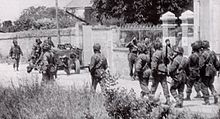Battle of Merville Gun Battery
Reduced to 75 men, the British succeeded in capturing the battery, only to discover that the guns were World War I-era Czech M.14/19 100 mm field howitzers, which only had an effective range of some 8,400 m (9,200 yd), just over 5 miles.The battalion's normal complement of 600 men[2][nb 1] was supported by a troop of sappers from 591st (Antrim) Parachute Squadron, Royal Engineers, eight Airspeed Horsa glider loads transporting Jeeps and trailers, and stores including explosives, an anti-tank gun and flamethrowers.[4] In April 1944, the force was taken to Walbury Hill in Berkshire, where over seven days the Royal Engineers had built a full-scale replica of the battery, including obstacles and barbed wire fences.[9] The predawn assault was planned to be completed and the battalion clear of the position by 05:00 AM, when the Royal Navy cruiser HMS Arethusa was set to open fire on the battery with naval gunfire.During a visit on 6 March 1944, to inspect the defences, Field Marshal Erwin Rommel ordered the builders to work faster, and by May 1944, the last two casemates were completed.While some men remained to mark out the company positions, the battalion's second in command, Major George Smith, and a reconnaissance party left to scout the battery.The pathfinders in the meantime were ineffective, as those who had arrived at the correct drop zone found their Eureka beacons had been damaged when they landed, and the smoke and debris from the bombing obscured their marker lights from the pilots of the transport aircraft.[14] The main body of the 9th Parachute Battalion and their gliders were to land from 01:00 at drop zone 'V', located between the battery and Varaville 4 km (2.5 mi) inland.[3] Aware of the time constraints, Otway decided he could wait no longer, and the reduced battalion headed for the battery and joined up with Major Smith's reconnaissance party just outside the village of Gonneville en Auge.[16] Otway launched the assault as soon as the first glider overshot the battery, ordering the explosives to be detonated to form two paths through the outer perimeter through which the paratroopers attacked.4 and 5 Troops of 3 Commando under command of Major John Pooley MC, carried out an attack on Merville battery, whose guns had been repaired and were again firing toward and several miles short of the landing beaches.


Operation TongaMervilleUnited KingdomGermanyTerence Otway9th Parachute Battalion3 Commando716th Infantry DivisionOperation OverlordAtlantic WallBodyguardFortitudeZeppelinTitanicTaxable, Glimmer & Big DrumCombined Bomber OffensivePointblankTransport PlanPostage AbleTarbrushFabiusCaen canal and Orne river bridgesMallardAmerican SectorAlbanyBostonChicagoDetroitElmiraNormandy landingsPointe du HocGambitPort-en-BessinAmericanOperation ChastityBritishMulberryBrécourt ManorGraignesLa Haye-du-PuitsSaint-LôCarentanHill 30CherbourgBrévilleVillers-BocageLe Mesnil-PatryNormandy massacresArdenne AbbeyDouvresMartletWindsorCharnwoodJupiter2nd OdonAtlanticGoodwoodVerrières RidgeSpringBluecoatTotalizeHill 140LüttichTractableHill 262ChamboisFalaiseSaint-MaloMantes-GassicourtLa RochelleUshantLa CainePierres NoiresAudierne BayJedburghDingsonSamwestCooneyBulbasketHoundsworthLoytonKiplingDragoonWallace & HardyCemeteriesSecond World War1st Airborne DivisionBitingFreshmanNorth AfricaTurkey BuzzardLadbrokeFustianSlapstickArnhemDoomsday6th Airborne DivisionVarsity2nd Parachute BrigadeAlliedMerville Gun BatterycalibreSword Beach3rd Parachute BrigadeCzech M.14/19 100 mmfield howitzersBritish paratroopersBritish CommandosGerman ArmyBritish 6th Airborne Division3rd British Infantry DivisionOuistrehamLieutenant Colonelsappers591st (Antrim) Parachute Squadron, Royal EngineersAirspeed Horsaanti-tank gunflamethrowerscoup de mainWalbury HillBerkshire224th (Parachute) Field Ambulance1st Canadian Parachute BattalionRoyal NavycruiserHMS Arethusa